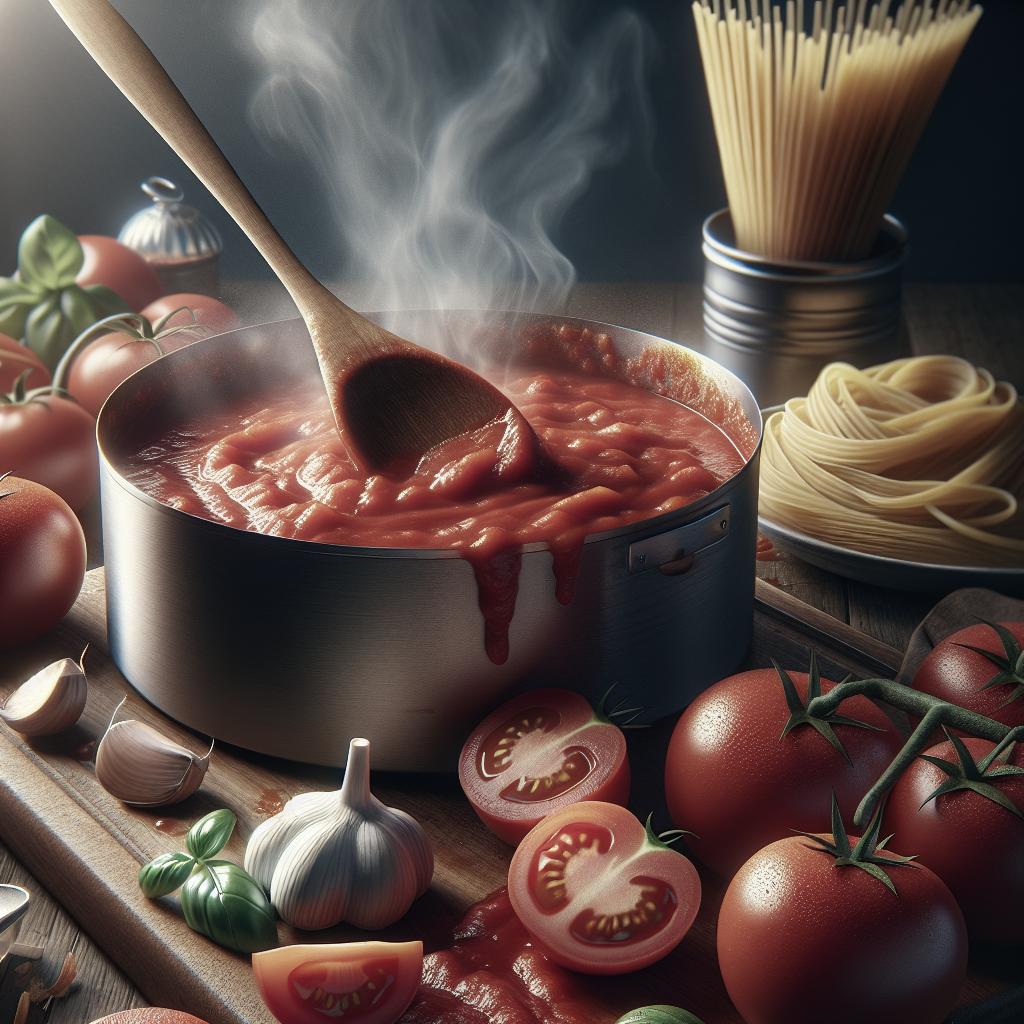“`html
How to Make a Simple Tomato Sauce for Pasta
If you’re looking for a straightforward and delightful way to enhance your pasta dishes, a homemade tomato sauce is an excellent choice. Easy to prepare and infinitely adaptable, this sauce serves as a perfect base for pasta nights, pizza toppings, or even a dipping sauce for appetizers. In this comprehensive guide, we’ll walk you through the essential ingredients and step-by-step instructions to prepare a rich and flavorful sauce. We’ll also answer common questions about using fresh tomatoes, storage options, and adapting the sauce for other culinary uses. Whether you’re cooking for a family dinner or meal prepping for the week, this homemade tomato sauce is sure to become a staple in your kitchen repertoire.
Easy Pasta Sauce
Ingredients
Crushed Tomatoes
Crushed tomatoes are the heart of any great tomato sauce. For our recipe, we recommend using high-quality canned crushed tomatoes. They provide a sweet, robust flavor that forms the backbone of the sauce. If you’re feeling adventurous, try different brands or types, like those imported from Italy, for a distinctive palate experience.
You can easily find crushed tomatoes in local stores, and they offer the convenience of consistency. Choose those without added herbs or spices if you aim to control the flavor profile yourself. The thick texture of crushed tomatoes is also ideal for a hearty pasta dish, ensuring the sauce clings well to the pasta without being too watery.
Onions and Garlic
Aromatics like onions and garlic are fundamental to building the savoriness and depth of flavor in tomato sauce. Finely chop one onion and crush two to three cloves of garlic to begin the aromatic base. Sautéing them in olive oil before adding other ingredients can unlock their full flavor potential and create a rich foundation for the sauce.
Onions offer a natural sweetness once cooked, balancing the acidity of the tomatoes. Garlic contributes a pungent kick that enhances the overall taste, making every bite irresistibly delicious. Adjusting the quantities of these ingredients to match your preference is a great way to personalize your sauce.
Butter
Butter might seem like an unusual addition for some, but it plays an essential role in enriching the sauce’s texture and taste. Just a couple of tablespoons can provide a silky finish, blending all the flavors into a harmonious medley.
The fat content of butter also helps in reducing acidity and balancing the robust taste of the tomatoes. If you prefer a dairy-free alternative, you could use olive oil exclusively, yet the unique smoothness butter brings is worth exploring for that perfect velvety sauce.
Dried Basil
Dried basil is a wonderful herb that adds a hint of sweetness and a fresh aroma to tomato sauce. While fresh basil can be used, dried basil has a concentrated flavor that melds well over a longer simmer, making it an excellent choice for this recipe.
Add about a tablespoon of dried basil towards the beginning of the cooking process to allow its flavors to infuse thoroughly into the sauce. The subtle yet aromatic presence of basil gives the tomato sauce a classic Italian touch, reminiscent of family recipes passed through generations.
Salt, Pepper, and Other Good Flavors
No tomato sauce is complete without a careful balance of salt and pepper. Start with a teaspoon of salt and half a teaspoon of black pepper, tasting and adjusting as needed to enhance the natural flavors of the tomatoes and other ingredients.
Beyond salt and pepper, consider adding a dash of red pepper flakes for heat, a sprinkle of oregano for an earthy note, or a hint of sugar to balance the sauce’s acidity. Tailoring these seasonings allows you to customize the sauce to match your flavor preferences or complement specific dishes.
Can I omit the sugar?
Sugar in tomato sauce is often added to counteract the natural acidity of tomatoes. While some recipes call for a teaspoon or so of sugar, it’s entirely optional. If you prefer a more acid-forward profile, feel free to omit the sugar or explore alternatives, such as grated carrots, which naturally sweeten the sauce.
Ultimately, the decision to include sugar depends on the sweetness of your tomatoes and personal taste preferences. It’s always a good idea to start with a small amount, taste, and adjust as your sauce simmers to find that perfect balance.
Instructions
Cook Time
The entire process of making this simple tomato sauce takes about 30 to 40 minutes. Start by heating olive oil in a saucepan, then add chopped onions and garlic. Sauté them until the onions become translucent and the garlic is fragrant, which should take around 5 minutes.
Next, stir in the crushed tomatoes, butter, dried basil, salt, and pepper. Bring the mixture to a gentle simmer. Allow it to cook uncovered for 20 to 30 minutes, stirring occasionally, until it thickens to your desired consistency. The longer you cook, the richer the flavor will become.
Can I use fresh tomatoes?
Fresh tomatoes can be a wonderful substitute for canned crushed tomatoes if you prefer a fresher taste or wish to use up what’s abundant in your garden. Begin by blanching the tomatoes to remove their skins, then chop them coarsely and add a can of tomato paste to help thicken the sauce.
Keep in mind, fresh tomatoes may add additional water to your sauce, so extending the cook time is necessary to achieve the desired consistency. While this approach requires a bit more effort, it’s rewarding and results in a fresher-tasting sauce.
Can I use this sauce for pizza?
This simple tomato sauce doubles beautifully as a pizza sauce with a few modifications. After the sauce has cooked and thickened, consider adding a dash more salt and a light sprinkle of Italian seasoning to intensify flavors specifically suited for pizza.
Ensure that the sauce is slightly thickened to prevent your pizza crust from becoming soggy. Allow the sauce to cool before spreading it over a pizza base, and you’ll have a delicious, homemade pizza sauce ready to go.
How do I freeze tomato sauce?
Freezing tomato sauce is an excellent way to have a quick meal base stored for future use. Once your sauce has cooled, transfer it into airtight containers or zip-lock freezer bags, removing as much air as possible to prevent freezer burn.
Label the containers with the date and type of sauce. When you’re ready to use it, thaw the sauce in the refrigerator overnight or gently reheat it on the stove, adding a splash of water to bring it back to the desired consistency if necessary.
Can I can this sauce?
Tomato sauce can be canned for preservation, though it’s important to follow safe canning practices to avoid contamination. The acidity of tomatoes makes them a safe candidate for water bath canning when done correctly with added lemon juice or vinegar to ensure safety.
If canning is your goal, thoroughly sterilize jars and lids. Following the proper canning procedure allows you to enjoy homemade tomato sauce for months, making it convenient to relish its goodness any time.
Final Thoughts
Mastering a simple tomato sauce opens up a myriad of culinary opportunities in your kitchen. It’s not only a staple accompaniment to pasta but also adaptable for pizzas and a variety of other dishes. Knowing how to adjust flavors, use different types of tomatoes, and store your sauce offers both versatility and convenience. This basic recipe provides a platform to build upon, encouraging you to experiment and discover your perfect balance of flavors.
| Section | Details |
|---|---|
| Ingredients | Crushed Tomatoes, Onions and Garlic, Butter, Dried Basil, Salt and Pepper |
| Sugar | Optional for balancing acidity |
| Cook Time | 30 to 40 minutes including prep |
| Use Fresh Tomatoes | Possible, with longer cook time and added tomato paste |
| Use as Pizza Sauce | Yes, with added seasoning modifications |
| Freezing | Yes, with proper storage containers |
| Canning | Feasible, with safe canning practices |
“`


